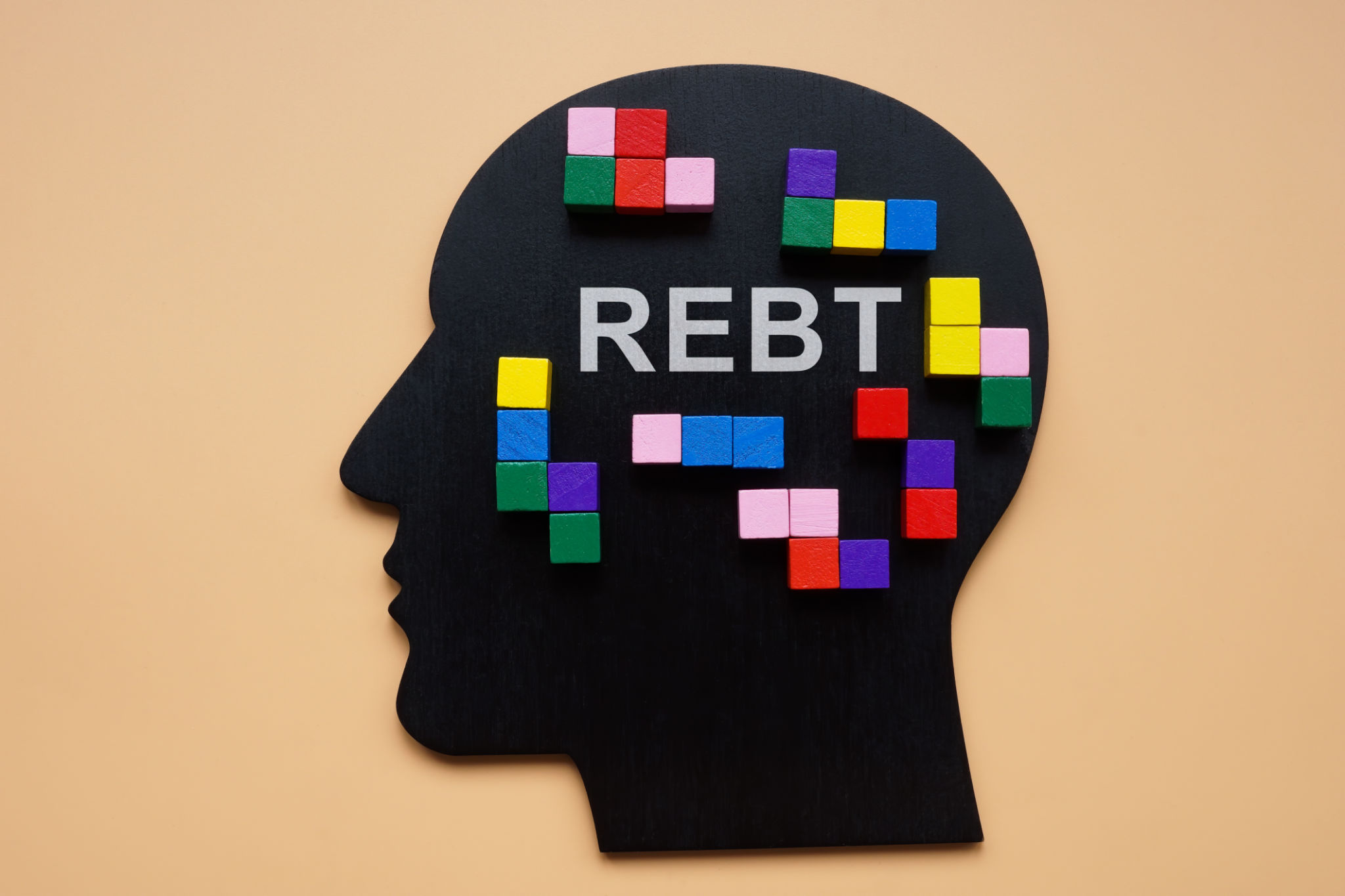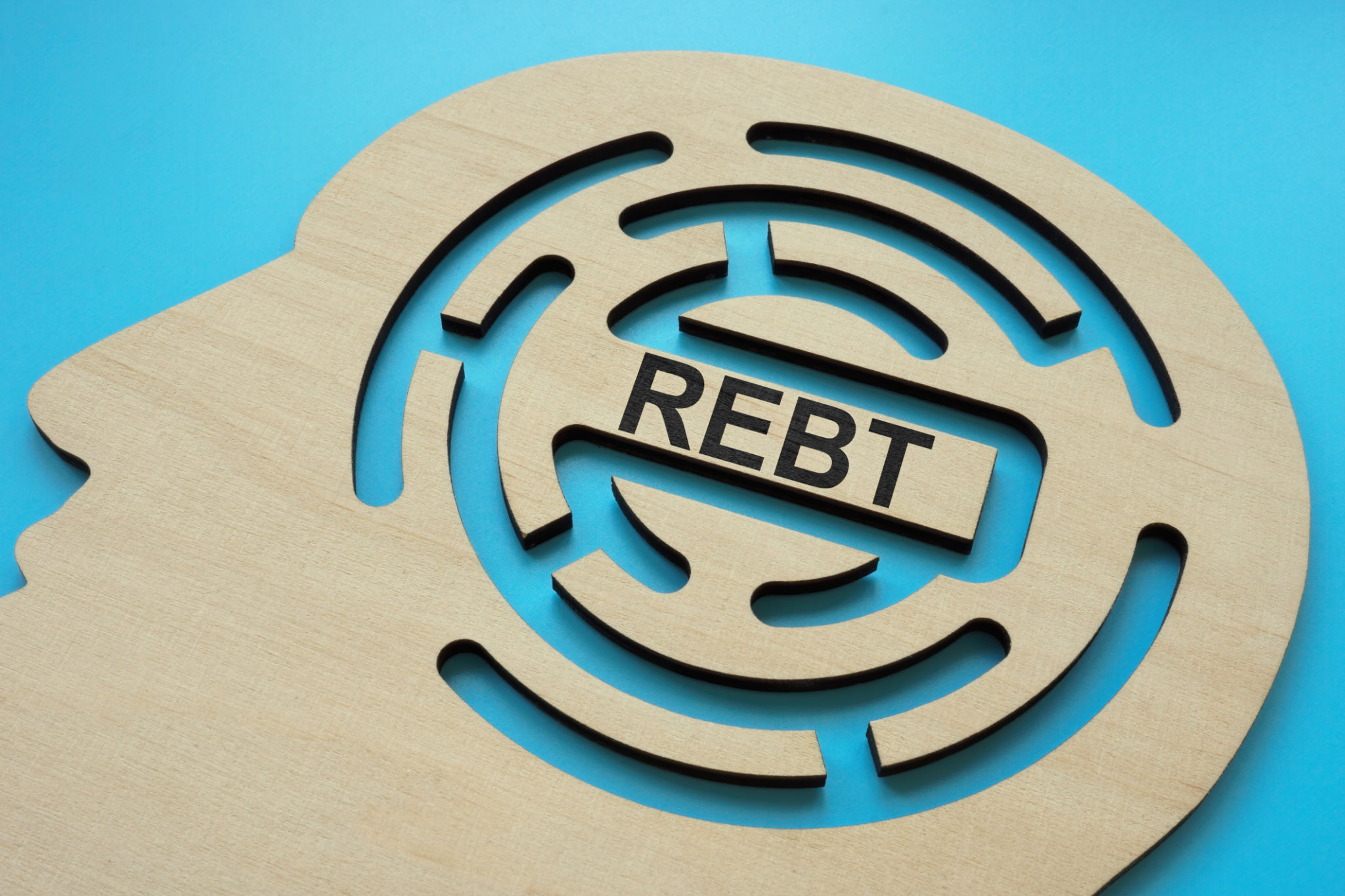Understanding Rational Emotive Behavior Therapy & Integrating REBT Into Self-Practice
Both the written article and the topical video overview on this page have unique content with differing insights. If you find these interesting to you, please download my new four-part series of short free ebooks that comprehensively cover understanding and integrating REBT, CBT, DBT, and ACT therapy modalities into self-practice on the free ebooks' page here
Most likely, you've experienced moments when your thoughts seemed to spiral out of control, leading to emotional distress and unwanted behaviors. Rational Emotive Behavior Therapy (REBT) offers you a powerful framework to understand and transform these patterns. As you explore this therapeutic approach, you'll discover how your beliefs shape your emotional responses and learn practical techniques to challenge irrational thoughts. This guide will walk you through the fundamentals of REBT and show you how to effectively incorporate its principles into your daily self-practice for better emotional well-
The Historical Context of REBT
Along with the emergence of cognitive therapies in the mid-20th century, REBT was developed by Dr. Albert Ellis in 1955. Your appreciation of REBT deepens when you consider that Ellis initially trained as a psychoanalyst but became disillusioned with the passive nature and limited effectiveness of traditional Freudian approaches. This dissatisfaction led him to create what was first called Rational Therapy, later renamed to better reflect the role of emotions and behavior in the therapeutic process.
Along the path of its development, REBT became the first comprehensive cognitive-behavioral therapy, predating Beck's Cognitive Therapy by several years. Your understanding of REBT's historical significance grows when you recognize how it revolutionized the field of psychotherapy by introducing the idea that thoughts, not external events, primarily influence your emotional responses and behaviors. This marked a significant departure from the dominant behavioral and psychoanalytic approaches of the time.
Along with its evolution, REBT has influenced numerous therapeutic approaches and continues to be refined and adapted. Your knowledge of its history helps you appreciate how the therapy has maintained its core principles while incorporating new research and practical applications. The approach has demonstrated remarkable resilience and adaptability, making it relevant across various cultural contexts and therapeutic settings.
Key Theoretical Foundations of REBT
Behind REBT lies the fundamental premise that your emotional disturbances stem not from external events themselves but from your beliefs about these events. When you encounter an adversity or activating event (A), your beliefs (B) about that event lead to emotional and behavioral consequences (C). This A-B-C model forms the cornerstone of REBT's theoretical framework.
Behind your irrational beliefs, REBT identifies several common patterns of thinking that can lead to emotional distress. These include demanding thinking ("must" and "should" statements), awfulizing (catastrophizing), low frustration tolerance, and global ratings of human worth. Your awareness of these patterns helps you identify when you're engaging in self-defeating thought processes.
Behind the practical application of REBT, you'll find a structured approach to identifying and challenging irrational beliefs. The therapy emphasizes the importance of developing rational alternative thoughts that are more flexible, realistic, and helpful in achieving your goals and maintaining emotional well-being.
To enhance your understanding of REBT's theoretical foundations, consider how the approach distinguishes between healthy and unhealthy negative emotions. Your response to adversity can be either appropriate and adaptive or inappropriate and maladaptive, depending on the nature of your underlying beliefs.
The Role of Emotions and Thinking in REBT
With REBT, you learn to recognize that emotions and thoughts are interconnected but distinct experiences. Your emotional responses are not direct results of events but are mediated through your thinking patterns and belief systems. This understanding empowers you to take control of your emotional experiences by examining and modifying your thoughts.
With practice in REBT principles, you discover that negative emotions aren't inherently problematic. Your goal isn't to eliminate negative emotions entirely but to transform unhealthy negative emotions (like anxiety and rage) into healthy negative emotions (like concern and annoyance). This transformation occurs through the systematic examination and modification of your belief systems.
With continued application of REBT techniques, you develop the ability to distinguish between rational and irrational beliefs. Your emotional well-being improves as you learn to challenge and replace rigid, absolute demands with flexible, preferential desires.
Hence, your journey through REBT involves developing a new relationship with your thoughts and emotions. The therapy provides you with practical tools to examine your thinking patterns, challenge unhelpful beliefs, and cultivate more adaptive ways of responding to life's challenges.

The ABC Model of REBT
If you're looking to understand the foundational principles of Rational Emotive Behavior Therapy (REBT), the ABC Model stands as its cornerstone. This model provides a structured framework for understanding how your thoughts influence your emotional and behavioral responses to life events.
Activating Events
The activating event represents the trigger or situation that initiates your emotional response. These events can range from minor daily hassles to significant life changes - perhaps a critical comment from your supervisor, a relationship breakup, or even getting stuck in traffic. It's vital to understand that activating events are objective facts about what happened, not your interpretation of them.
When you identify activating events in your life, you'll notice they often fall into common categories: interpersonal conflicts, performance-related situations, losses, changes, or perceived threats to your well-being. By learning to recognize these events clearly and objectively, you develop a stronger foundation for understanding your emotional responses. This clarity helps you separate what actually happened from your thoughts about what happened.
You might find it helpful to think of activating events as the first domino in a sequence. While they set things in motion, they don't directly cause your emotional responses. Instead, they serve as triggers that activate your belief system, leading to various consequences. Understanding this distinction empowers you to focus on the aspects of your experience that you can control, rather than getting caught up in circumstances beyond your influence.
Beliefs
Activating events trigger your belief system, which encompasses both rational and irrational beliefs about yourself, others, and the world. These beliefs act as a filter through which you interpret events and determine their meaning. Your beliefs might include absolute demands (musts, shoulds, oughts), awfulizing (viewing situations as worse than they actually are), or low frustration tolerance beliefs.
When you examine your beliefs closely, you'll discover that rational beliefs tend to be flexible, realistic, and logical, while irrational beliefs are often rigid, unrealistic, and illogical. For example, after receiving criticism, a rational belief might be "I would prefer to receive positive feedback, but criticism can help me improve." In contrast, an irrational belief might be "I must always receive approval, or it means I'm worthless."
Your belief system develops over time through various influences, including early experiences, cultural conditioning, and learned responses. By becoming aware of these beliefs and their origins, you can begin to challenge and modify those that don't serve you well. This awareness forms the foundation for meaningful change in your emotional responses and behaviors.
Considering the impact of beliefs on your emotional well-being, it becomes clear that they serve as the primary determinant of your psychological responses to activating events. When you understand this relationship, you gain the power to question and modify beliefs that create unnecessary emotional distress.
Consequences
Below the surface of every emotional reaction lie consequences - the emotional, behavioral, and physiological responses that result from the interaction between activating events and your beliefs. These consequences can manifest as feelings like anxiety, depression, or anger; behaviors such as avoidance or aggression; and physical symptoms like tension headaches or increased heart rate.
When you experience consequences, they often feel automatic and beyond your control. However, by understanding that these responses stem from your beliefs rather than directly from events, you gain the ability to influence them. This understanding opens the door to developing more adaptive responses to challenging situations.
Your consequences can serve as valuable indicators of underlying beliefs that might need examination and modification. For instance, if you notice yourself consistently responding with intense anxiety to mild criticism, this pattern might point to underlying beliefs about perfectionism or approval-seeking that warrant exploration.
But it's important to note that consequences aren't always negative. When your beliefs are rational and flexible, you're more likely to experience healthy negative emotions like concern instead of anxiety, sadness instead of depression, and disappointment instead of rage. These healthier emotional responses typically lead to more constructive behaviors and better long-term outcomes.

Identifying Irrational Beliefs
Despite your best intentions to maintain a balanced perspective, irrational beliefs can subtly influence your thoughts and behaviors without your conscious awareness. Understanding how to identify these beliefs is a fundamental step in applying REBT effectively to your daily life.
Common Types of Irrational Beliefs
Along with the basic framework of REBT, there are several distinct categories of irrational beliefs that you might encounter in your thought patterns. These beliefs often manifest as absolute demands about yourself, others, and the world around you. They typically involve unrealistic expectations and rigid thinking that can significantly impact your emotional well-being.
Demandingness: "I must succeed at everything I do"
Awfulizing: "It would be terrible if I made a mistake"
Low Frustration Tolerance: "I can't handle difficult situations"
Global Rating: "If I fail at something, I'm a complete failure"
Perfectionism: "Everything must be done perfectly"
Knowing these common patterns helps you identify similar thoughts in your own thinking processes.
The Impact of Irrational Beliefs on Emotions
Between your thoughts and emotional responses lies a complex relationship that's heavily influenced by your beliefs. When these beliefs are irrational, they can trigger intense emotional reactions that may seem disproportionate to the actual situation.
Your irrational beliefs can create a self-reinforcing cycle where negative emotions lead to more rigid thinking, which in turn generates stronger emotional responses. This pattern can affect your decision-making abilities and interpersonal relationships, creating unnecessary stress and anxiety in your daily life.
The emotional impact of irrational beliefs extends beyond momentary distress, potentially leading to long-term patterns of emotional dysregulation and maladaptive coping strategies.
Beliefs that maintain an irrational nature can significantly impact your physical health through increased stress levels, disrupted sleep patterns, and compromised immune function, highlighting the importance of addressing these thought patterns promptly.
Techniques for Recognizing Irrational Beliefs
Irrational beliefs often hide behind seemingly logical justifications, making them challenging to identify without specific techniques and strategies. By developing your awareness and using structured approaches, you can become more adept at spotting these beliefs as they arise.
Your journey to recognizing irrational beliefs involves regular self-monitoring and reflection. This includes keeping thought journals, analyzing your emotional reactions, and questioning your automatic assumptions about situations that trigger strong emotional responses.
The process of identifying irrational beliefs becomes more natural with practice, as you develop a better understanding of your thought patterns and emotional triggers. This skill forms the foundation for implementing effective REBT interventions.
Common challenges in recognizing irrational beliefs include confirmation bias, emotional reasoning, and deeply ingrained thought patterns. By maintaining awareness of these potential obstacles, you can develop more effective strategies for identifying and challenging your irrational beliefs.
Disputing Irrational Beliefs
Unlike traditional therapeutic approaches, REBT places significant emphasis on actively challenging and disputing irrational beliefs that cause emotional distress. When you engage in the disputing process, you're vitally becoming your own cognitive scientist, examining your thoughts with precision and objectivity.
Types of Disputes: Empirical, Logical, and Pragmatic
Empirical disputes focus on testing beliefs against reality by gathering evidence. You'll need to examine whether your beliefs align with factual evidence, considering both historical and current data. When you challenge beliefs empirically, you're asking questions like "Where's the evidence?" and "How can I verify this belief?"
Logical disputes examine the rationality and consistency of your beliefs. You'll investigate whether your conclusions follow logically from your premises. For example, if you believe "I must perform perfectly at work to be worthwhile," you'll examine the logical connection between performance and human worth.
Pragmatic disputes assess the usefulness of holding certain beliefs. You'll evaluate whether maintaining specific thoughts helps you achieve your goals or creates unnecessary obstacles. Knowing these three types of disputes enables you to select the most effective approach for different situations.
Empirical Disputes: Evidence-based questioning
Logical Disputes: Rational consistency examination
Pragmatic Disputes: Utility assessment
Combined Approach: Integration of multiple dispute types
Dispute Type
Key Questions
Empirical
Where's the evidence? What are the facts?
Logical
Does this belief make sense? Is it rational?
Pragmatic
Is this belief helpful? What are its consequences?
Combined
How can I integrate multiple approaches?
Results
What outcomes am I achieving?
The Process of Disputing Irrational Beliefs
Among the most effective ways to dispute irrational beliefs is following a structured process. You'll start by identifying the triggering event, then clearly articulating your beliefs about it. Next, you'll examine the emotional and behavioral consequences of these beliefs.
During the disputing process, you'll need to maintain a curious and investigative mindset. Your role is to question your thoughts systematically, using evidence and reason rather than emotion. This approach helps you develop more balanced and realistic perspectives.
As you progress through disputation, you'll learn to recognize patterns in your thinking and develop more effective responses. You'll build a toolkit of questions and approaches that work best for your specific situation.
This systematic approach to disputing beliefs becomes more natural with practice. You'll find yourself automatically questioning irrational thoughts as they arise, leading to more balanced emotional responses and behaviors.

Developing Rational Beliefs
The Importance of Rational Beliefs
To effectively transform your emotional and behavioral responses, understanding and developing rational beliefs serves as the cornerstone of REBT practice. Rational beliefs provide you with a balanced, flexible, and reality-based framework through which you can interpret and respond to life's challenges. These beliefs help you maintain emotional equilibrium while facing adversity, allowing you to process difficult situations without falling into patterns of self-defeating thoughts.
To enhance your psychological resilience, rational beliefs act as protective factors against emotional disturbance. When you cultivate rational beliefs, you develop the ability to accept reality as it is, rather than demanding it should be different. This acceptance doesn't mean passive resignation; instead, it empowers you to take constructive action while maintaining emotional stability, even when circumstances don't align with your preferences.
To build a foundation for lasting change, rational beliefs support your long-term emotional well-being by promoting realistic expectations and healthy perspectives. These beliefs enable you to distinguish between healthy negative emotions (like concern or sadness) and unhealthy negative emotions (like anxiety or depression). By maintaining rational beliefs, you can experience appropriate emotional responses while avoiding the trap of excessive or prolonged emotional disturbance.
Principles for Formulating Rational Beliefs
Around the core of REBT theory lie several fundamental principles for developing rational beliefs. These principles emphasize flexibility over rigidity, preferences over demands, and acceptance over resistance. When formulating rational beliefs, you should focus on creating statements that are logical, empirical, and pragmatic - ensuring they serve your goals and emotional well-being effectively.
Around your daily experiences, rational beliefs should be grounded in reality rather than wishful thinking or catastrophic predictions. They should acknowledge both the positive and negative aspects of situations while maintaining a balanced perspective. Your rational beliefs need to be specific enough to be meaningful yet flexible enough to adapt to changing circumstances.
Around your personal growth journey, developing rational beliefs requires consistent practice and self-reflection. You'll need to regularly examine your thought patterns, challenge your existing beliefs, and consciously work to replace irrational thoughts with more balanced, realistic alternatives. This process involves recognizing that while you may have strong preferences for certain outcomes, demanding they must occur leads to emotional disturbance.
This approach to formulating rational beliefs emphasizes the importance of using language that reflects flexibility and acceptance. You'll want to replace absolute terms like "must," "should," and "have to" with more flexible language such as "prefer," "would like," and "choose to." This shift in language helps reshape your cognitive patterns and emotional responses.
Exercises to Cultivate Rational Thinking
Importance of regular practice cannot be overstated when it comes to developing rational thinking patterns. Through structured exercises and consistent application, you can strengthen your ability to generate and maintain rational beliefs. Begin by identifying and writing down your current beliefs about challenging situations, then practice reframing them using the principles of rational thinking.
Importance lies in regularly challenging your irrational beliefs through specific exercises designed to reinforce rational thinking patterns. You can use thought records to track situations that trigger emotional responses, identify the underlying beliefs, and practice developing more rational alternatives. This process helps you build a library of rational responses to common challenges.
Importance of self-dialogue becomes evident as you practice rational thinking exercises. You can develop the habit of questioning your thoughts using the ABC model, where you examine the Activating event, your Beliefs about it, and the resulting Consequences. This systematic approach helps you identify and modify irrational beliefs more effectively.
For instance, you might benefit from creating a daily practice routine that includes specific exercises like the "Three-Column Technique," where you write down an irrational belief in the first column, its consequences in the second, and a rational alternative in the third. Other helpful exercises include role-playing challenging situations, keeping a rational beliefs journal, and practicing rational responses to hypothetical scenarios.

Emotional and Behavioral Changes through REBT
All transformative work in REBT centers around the understanding that your thoughts, emotions, and behaviors are interconnected systems that influence each other continuously. When you modify one aspect, you create a ripple effect that impacts the others, leading to comprehensive personal growth and improved mental well-being.
The Connection Between Emotions and Behaviors
Any shift in your emotional state directly influences your behavioral patterns, and vice versa. When you experience intense negative emotions like anxiety or anger, your actions often reflect these internal states through avoidance, aggression, or withdrawal. Understanding this connection helps you identify the triggers and patterns that maintain unhelpful cycles in your life.
Your emotional responses to situations stem from your underlying beliefs and interpretations. REBT teaches you to examine these beliefs critically, helping you recognize that changing your perspective can lead to different emotional experiences. As your emotional reactions become more balanced, your behavioral choices naturally expand, allowing you to respond to challenges more effectively.
Your ability to regulate emotions through REBT principles directly impacts your behavioral flexibility. When you learn to challenge and modify unhelpful beliefs, you'll notice that your emotional responses become less intense and more appropriate to the situation. This emotional regulation creates space for you to choose behaviors that align with your goals rather than acting on immediate emotional impulses.
Implementing Behavioral Change Techniques
About implementing behavioral change, REBT offers specific techniques that help you modify both your emotional responses and subsequent actions. You'll learn to identify triggers, develop coping strategies, and practice new behaviors in a systematic way. This structured approach ensures that your changes are sustainable and meaningful.
Your success in behavioral change depends on consistent practice and application of REBT principles in real-life situations. The therapy encourages you to start with smaller, manageable changes and gradually work toward more challenging behavioral modifications. This progressive approach helps build your confidence and reinforces positive outcomes.
Your journey through behavioral change includes regular self-assessment and adjustment of strategies as needed. REBT provides you with tools to monitor your progress, celebrate successes, and learn from setbacks. This ongoing process of evaluation and refinement ensures that your behavioral changes become permanent improvements.
Through consistent application of REBT techniques, you'll develop a comprehensive toolkit for managing both emotional reactions and behavioral responses. This integration allows you to maintain progress even in challenging situations, making your personal growth more resilient and long-lasting.
Role-Playing and Exposure Techniques in REBT
Below the surface of theoretical understanding lies the practical application of role-playing and exposure techniques in REBT. These methods allow you to practice new behaviors and emotional responses in a controlled environment before facing real-world challenges. By simulating challenging situations, you can develop confidence and competence in handling similar scenarios effectively.
Your engagement in role-playing exercises provides opportunities to receive feedback and refine your approaches. These practice sessions help you identify potential obstacles and develop strategies to overcome them, making your behavioral changes more robust and adaptable to different situations.
Your progress through exposure techniques involves gradually facing situations that typically trigger unhelpful emotional and behavioral responses. This systematic approach helps you build resilience while practicing new coping strategies, ultimately leading to lasting behavioral change.
Emotions play a central role in exposure and role-playing exercises, as these techniques help you develop greater emotional intelligence and behavioral flexibility. Through repeated practice, you'll find yourself naturally choosing more constructive responses to challenging situations, demonstrating the effectiveness of these REBT techniques in creating lasting change.

The Integration of REBT in Daily Life
After learning the fundamental principles of REBT, incorporating these concepts into your daily routine becomes an vital step toward lasting psychological well-being. The transformation of theoretical understanding into practical application requires dedication, consistency, and a structured approach. By integrating REBT principles into your everyday life, you create opportunities for continuous personal growth and emotional resilience.
Daily Practices to Reinforce REBT Principles
Daily implementation of REBT begins with monitoring your thoughts and emotional responses to various situations. Start by identifying triggering events and your immediate emotional reactions. Take time throughout the day to pause and evaluate whether your thoughts align with rational beliefs or if they stem from irrational thinking patterns. This consistent self-monitoring helps you develop awareness of your cognitive processes.
Your practice should include regular challenging of irrational beliefs as they arise. When faced with adversity, apply the ABC model: identify the Activating event, examine your Beliefs about it, and consider the emotional and behavioral Consequences. Question your thoughts using empirical, logical, and pragmatic criteria. Ask yourself if your beliefs are based on evidence, if they make logical sense, and if they help you achieve your goals.
Throughout your day, actively work on developing and reinforcing rational alternative thoughts. Create specific statements that counter your irrational beliefs and repeat them regularly. Practice accepting uncertainty and imperfection in various situations, whether at work, in relationships, or during personal activities. This continuous reinforcement helps establish new neural pathways and strengthens your rational thinking patterns.
Journaling and Self-Reflection Techniques
By maintaining a dedicated REBT journal, you create a valuable tool for tracking your progress and identifying patterns in your thinking. Document situations that trigger emotional responses, your initial thoughts, and the process of challenging and replacing irrational beliefs. This written record serves as both a learning tool and a reference for future similar situations.
Your journaling practice should include regular reviews of past entries to identify recurring themes and measure your progress. Set aside time each week to analyze your documented experiences, noting improvements in your emotional responses and areas that still need attention. This systematic review helps you refine your approach and adjust your strategies as needed.
Through consistent self-reflection, you develop a deeper understanding of your thought patterns and emotional triggers. Use your journal to explore connections between different life experiences and your responses to them. This analysis helps you identify broader patterns and develop more effective strategies for managing challenging situations.
Techniques for effective journaling include structured templates that guide you through the REBT process, emotion rating scales to track intensity changes, and specific sections for documenting successful belief challenges. Consider using digital tools or apps designed for REBT practice, which can provide additional features like reminder notifications and progress tracking.
Building a Support System for REBT Practice
REBT practice becomes more effective when you establish a supportive network of individuals who understand and encourage your journey. This network might include professional therapists, support groups, or friends who are also interested in personal development. Regular interaction with these supporters provides opportunities for feedback, accountability, and shared learning experiences.
Your support system should include various resources that aid your REBT practice. Consider joining online communities focused on REBT, attending workshops or seminars, and maintaining regular contact with a qualified REBT practitioner. These connections provide valuable perspectives and help you stay motivated during challenging periods.
Through your support network, you can engage in role-playing exercises, discuss complex situations, and receive constructive feedback on your thought processes. Regular interaction with others practicing REBT helps normalize the experience of working through irrational beliefs and provides additional strategies for managing difficult emotions.
Practice building your support system gradually, starting with one or two trusted individuals and expanding as you become more comfortable sharing your REBT journey. Look for opportunities to connect with others who share similar goals for emotional well-being and personal growth. Consider creating or joining a local REBT study group where you can regularly discuss challenges and successes with like-minded individuals.

REBT in Different Contexts
Now that you understand the fundamental principles of REBT, let's explore how this therapeutic approach adapts and functions in various therapeutic settings. Each context presents unique opportunities and challenges for implementing REBT techniques effectively.
REBT in Individual Therapy
At its core, REBT in individual therapy provides you with a personalized space to explore your thoughts, beliefs, and behaviors with focused attention from your therapist. In this one-on-one setting, you'll have the opportunity to deeply examine your irrational beliefs and work through the ABC model at your own pace. Your therapist can tailor the approach specifically to your needs, helping you identify patterns in your thinking that might be harder to recognize in other therapeutic settings.
During individual REBT sessions, you'll find yourself engaging in direct dialogue with your therapist, who serves as both a guide and a challenger to your irrational beliefs. This intimate therapeutic setting allows you to practice disputing techniques more intensively, with immediate feedback and guidance. You can work through personal examples and scenarios that might be too private or complex to address in group settings, while developing a stronger understanding of how your belief systems influence your emotional responses.
The individual therapy format also enables you to progress through REBT's stages at a pace that matches your comfort level and learning style. Your therapist can adjust the intensity of cognitive challenges and homework assignments based on your progress and emotional readiness. This personalized approach helps you build confidence in applying REBT principles to your daily life while maintaining a supportive therapeutic alliance.
REBT in Group Therapy
Between the dynamics of shared experiences and collective learning, REBT group therapy offers unique advantages for your personal growth. In a group setting, you benefit from witnessing others' progress and challenges, which can normalize your own experiences and provide multiple perspectives on similar issues. The group format allows you to observe how different people apply REBT principles to various life situations, expanding your understanding of the therapy's versatility.
When participating in REBT group therapy, you'll find yourself part of a supportive community where members can practice disputing techniques together and offer feedback to one another. This collaborative environment enhances your learning through peer support and shared problem-solving. You may discover new ways to challenge irrational beliefs by listening to how others in the group approach similar situations.
The group setting also provides you with opportunities to role-play challenging situations and practice new behaviors in a safe environment. You can receive immediate feedback from both the therapist and other group members, helping you refine your REBT skills and build confidence in implementing them in real-world situations.
Due to the collective nature of group therapy, you'll find that the shared experiences and mutual support create a powerful learning environment. The diversity of perspectives and problems presented in group sessions helps you develop a broader understanding of how REBT can be applied to various life challenges, while the group dynamic itself provides additional motivation and accountability for your personal growth journey.
REBT for Couples and Family Therapy
After recognizing that relationship dynamics often involve intertwined belief systems, REBT for couples and families focuses on helping you and your loved ones identify and modify collective irrational beliefs. This approach addresses how individual beliefs affect relationship patterns and teaches you to work together in developing more rational, helpful ways of thinking and communicating.
In couples and family REBT sessions, you'll learn to recognize how your individual belief systems interact with and influence each other. The therapist guides you through exercises that highlight these interactions, helping you understand how one person's irrational beliefs can trigger emotional responses in others, creating cycles of conflict or distress. Through this process, you develop skills to support each other in maintaining more rational perspectives.
The family or couple context provides unique opportunities to practice REBT principles in real-time with the people most important to you. You'll learn to apply dispute techniques collaboratively, working together to challenge unhelpful beliefs and develop more constructive ways of handling relationship challenges. This collaborative approach strengthens both individual emotional resilience and relationship bonds.
Hence, by engaging in REBT within the family or couple context, you create a supportive environment where all members can grow together. This shared understanding and practice of REBT principles often leads to improved communication, stronger emotional bonds, and more effective problem-solving

Challenges and Obstacles in REBT Practice
Common Misunderstandings of REBT
After beginning your journey with REBT, you might encounter several misconceptions that could hinder your progress. One common misunderstanding is the belief that REBT suggests you should never experience negative emotions. In reality, REBT acknowledges that all emotions, including negative ones, are natural and valid. The goal is to transform unhealthy negative emotions (like anxiety and depression) into healthy negative emotions (like concern and sadness) that don't interfere with your ability to function and achieve your goals.
Another frequent misinterpretation is viewing REBT as overly simplistic or merely positive thinking. You might initially think that disputing irrational beliefs is just about replacing negative thoughts with positive ones. However, REBT is far more nuanced - it's about developing a realistic and flexible philosophy of life. The approach encourages you to examine your core beliefs systematically and develop rational alternatives based on empirical evidence, logic, and pragmatism.
Some practitioners also mistakenly believe that REBT dismisses the importance of past experiences and childhood influences. In fact, REBT acknowledges how your past shapes your current belief system but emphasizes that you have the power to change these beliefs in the present. The focus remains on how you maintain your current emotional difficulties through your present beliefs rather than solely attributing them to historical causes.
Addressing Resistance to Change
Behind many cases of resistance to REBT lies a deep-seated attachment to long-held beliefs and familiar patterns of thinking. You might find yourself clinging to irrational beliefs because they've become part of your identity or because they seem to offer some perceived benefit, such as avoiding responsibility or maintaining a sense of control.
The process of challenging and changing your core beliefs can feel threatening and uncomfortable. You might experience what therapists call "secondary disturbance" - becoming upset about being upset, or feeling guilty about your resistance to change. This meta-emotional response can create additional barriers to progress in your REBT practice.
Your resistance might also stem from the misconception that accepting rational beliefs means becoming emotionally detached or losing your authenticity. This fear can make you hesitant to fully engage with the REBT process, even when you intellectually understand its principles.
For instance, when you're working through resistance, you might notice that certain irrational beliefs feel protective or comforting, like believing "I must be perfect to be worthy." While this belief causes emotional distress, it might also feel like a motivating force in your life. REBT helps you understand that you can maintain high standards and motivation while adopting more rational beliefs that promote psychological well-being.
Overcoming Barriers to Effective Practice
Challenges in implementing REBT effectively often begin with difficulty in identifying and articulating your irrational beliefs. You might find yourself focusing on surface-level thoughts rather than diving deeper to uncover the core beliefs that drive your emotional responses. This can lead to frustration and a sense that the technique isn't working as effectively as it should.
The demanding nature of consistent REBT practice can also present obstacles. You might struggle to maintain regular self-reflection and belief disputation exercises, especially when dealing with daily stressors or time constraints. The process requires dedication and patience, as changing long-standing thought patterns takes sustained effort and practice.
Environmental factors can also impede your progress in REBT. You might find that people in your life inadvertently reinforce your irrational beliefs or express skepticism about your efforts to change. Additionally, societal messages and cultural beliefs can sometimes conflict with the rational alternatives you're working to adopt.
At this point in your REBT journey, it's valuable to recognize that overcoming barriers requires a combination of persistence, self-compassion, and practical problem-solving. When you encounter obstacles, treat them as opportunities to strengthen your rational thinking skills rather than viewing them as evidence that the approach isn't working for you.

Tools and Techniques for Practicing REBT
Keep in mind that successful implementation of REBT requires consistent practice and the right set of tools at your disposal. As you commence on your journey of emotional and behavioral transformation, having access to practical resources will significantly enhance your ability to apply REBT principles effectively in your daily life.
Worksheets and Handouts for Self-Use
Along with regular practice, REBT worksheets serve as valuable tools for documenting and analyzing your thoughts, emotions, and behaviors. These structured forms help you identify activating events (A), examine your beliefs (B), and track the consequences (C) of your thought patterns. By maintaining a detailed record, you can better understand the connections between these elements and work towards positive change.
The ABC worksheets form the foundation of your REBT practice, but you'll also benefit from dispute sheets that challenge irrational beliefs and help you develop more rational alternatives. These materials guide you through the process of questioning your automatic thoughts and replacing them with more balanced, realistic perspectives. You can customize these worksheets to address specific situations and challenges you encounter.
Your REBT journey can be further enhanced by using emotion tracking sheets, which allow you to monitor your emotional responses over time and identify patterns in your reactions. These tools help you measure your progress and adjust your approach as needed. Additionally, goal-setting worksheets assist you in establishing realistic objectives and creating action plans for implementing new rational beliefs.
Online Resources and Applications for REBT
An expanding digital landscape has made REBT more accessible than ever through various online platforms and mobile applications. These tools offer interactive exercises, guided sessions, and progress tracking features that complement traditional REBT practices. Many applications provide daily reminders and exercises to help you maintain consistency in your practice.
Your digital REBT toolkit can include meditation apps with specific cognitive restructuring exercises, mood tracking applications that help you identify triggers and patterns, and online communities where you can share experiences and insights with others practicing REBT. These resources often incorporate multimedia elements such as videos, audio guides, and interactive worksheets to enhance your learning experience.
As you explore digital REBT resources, you'll find platforms that offer personalized feedback and recommendations based on your progress and specific challenges. These adaptive tools can help you focus on areas where you need the most support while maintaining engagement through gamification elements and achievement tracking.
This digital approach to REBT practice allows you to access support and guidance whenever and wherever you need it, making it easier to maintain consistency in your personal development journey. The combination of traditional REBT principles with modern technology creates a comprehensive support system for your emotional and behavioral growth.
Recommended Books and Literature on REBT
Recommended reading materials on REBT range from foundational texts by Albert Ellis to modern interpretations and practical guides. These resources provide in-depth explanations of REBT principles, case studies, and exercises that you can incorporate into your practice. The literature available covers various aspects of REBT, from basic concepts to advanced applications in specific life situations.
Your understanding of REBT can be significantly enhanced by exploring both theoretical works and practical guidebooks. Many authors offer unique perspectives and specialized approaches for applying REBT principles to different areas of life, such as relationships, career challenges, or personal growth. These resources often include real-world examples and step-by-step instructions for implementing REBT techniques.
As you build your REBT library, you'll find that different authors emphasize various aspects of the therapy, providing a well-rounded understanding of how to apply these principles in different contexts. Some books focus on specific techniques or applications, while others offer comprehensive overviews of the entire REBT framework.
Practicing REBT through literature allows you to deepen your knowledge at your own pace and reference specific techniques when needed. By maintaining a collection of trusted REBT resources, you can continue to refine your practice and discover new approaches to addressing challenging situations in your life.

Advanced Strategies in REBT
To master REBT at an advanced level, you'll need to explore sophisticated techniques and approaches that build upon the fundamental principles.
Here's a comprehensive breakdown of advanced REBT strategies:
Deep-level disputation techniques for complex beliefs
Multi-dimensional emotional analysis
Advanced cognitive restructuring methods
Integration of mindfulness with REBT principles
Development of personalized coping statements
Advanced Technique
Implementation Strategy
Philosophical Disputation
Examine core beliefs through logical analysis and empirical evidence
Emotional Sophistication
Develop nuanced understanding of emotional responses and triggers
Behavioral Experimentation
Design and execute structured behavioral challenges
Integrative Approaches with Other Therapeutic Techniques
About combining REBT with other therapeutic approaches, you'll find that integration can enhance your overall treatment effectiveness. By incorporating elements from cognitive behavioral therapy (CBT), mindfulness-based practices, and solution-focused approaches, you can create a more comprehensive therapeutic toolkit that addresses various aspects of your emotional well-being.
When you blend REBT with mindfulness techniques, you'll develop a heightened awareness of your thought patterns while maintaining the rational-emotive framework. This combination allows you to observe your irrational beliefs as they arise and apply REBT principles in real-time, creating a more dynamic and responsive approach to emotional management.
Your practice can also benefit from incorporating elements of positive psychology and acceptance-based approaches. These additions complement REBT's focus on rational thinking by fostering resilience, personal growth, and self-acceptance, leading to a more balanced and sustainable therapeutic outcome.
Tailoring REBT for Special Populations
Above all, when adapting REBT for different populations, you'll need to consider unique cultural, developmental, and contextual factors. Your approach should be flexible enough to accommodate varying cognitive abilities, cultural beliefs, and personal circumstances while maintaining the core principles of rational-emotive theory.
While working with diverse populations, you'll discover that modifying the delivery and presentation of REBT concepts can significantly impact their effectiveness. This might involve adjusting language complexity, using culturally relevant examples, or incorporating age-appropriate metaphors to explain key concepts.
Through careful consideration of individual differences, you can create personalized REBT interventions that resonate with specific population needs while preserving the therapeutic integrity of the approach.
With specialized populations, your focus should extend to developing targeted interventions that address specific challenges while maintaining sensitivity to unique circumstances and requirements.

Long-Term Personal Development Using REBT
At the core of long-term REBT practice, you'll find that sustained personal growth requires consistent application and refinement of your skills. As you progress in your REBT journey, you'll develop increasingly sophisticated ways to identify and challenge irrational beliefs, leading to more profound and lasting changes in your thought patterns.
Your ongoing development will involve regular self-assessment and adaptation of REBT techniques to meet evolving personal challenges. This process includes deepening your understanding of philosophical principles underlying REBT and expanding your repertoire of coping strategies.
Through dedicated practice and continuous learning, you'll establish a robust foundation for maintaining emotional well-being and rational thinking patterns that serve you throughout your life journey.
It becomes crucial to view REBT as a lifelong practice rather than a short-term solution, incorporating its principles into your daily routine and decision-making processes.
Measuring Progress in REBT
Many practitioners and individuals engaging in REBT find that tracking progress is vital for maintaining motivation and ensuring the effectiveness of their therapeutic journey. Understanding how to measure your advancement in REBT helps you stay focused on your goals while providing tangible evidence of your psychological growth and emotional development.
Self-Assessment Techniques
Measuring your progress in REBT begins with establishing reliable self-assessment methods. You can start by maintaining a detailed thought diary where you record your irrational beliefs, the situations that trigger them, and your emotional and behavioral responses. This documentation serves as a baseline for tracking changes in your thinking patterns and helps you identify areas where you've made improvements or need additional focus.
Regular emotional ratings provide another valuable self-assessment tool. You can rate the intensity of your emotional responses to challenging situations on a scale of 0-10, both before and after applying REBT techniques. This quantitative approach allows you to observe gradual improvements in your emotional regulation and helps you recognize when specific interventions are particularly effective for you.
Your self-assessment should also include periodic reviews of your behavioral changes. Creating a weekly log of situations where you successfully challenged irrational beliefs and responded more adaptively can provide concrete evidence of your progress. This documentation helps reinforce your commitment to REBT principles and builds confidence in your ability to maintain rational thinking patterns.
Setting Achievable Goals
Setting specific, measurable goals is fundamental to your REBT journey. Begin by identifying the irrational beliefs you want to address and create concrete objectives for changing these thought patterns. Your goals should be realistic and broken down into manageable steps, allowing you to experience regular success while working toward larger emotional and behavioral changes.
Your goal-setting process should incorporate both short-term and long-term objectives. Short-term goals might include practicing dispute techniques daily or reducing the frequency of specific negative thoughts, while long-term goals could focus on maintaining rational beliefs during challenging life events or developing more flexible thinking patterns across various situations.
The effectiveness of your goals depends on their clarity and measurability. Each goal should have specific criteria for success and a realistic timeframe for achievement. This structured approach helps you maintain focus and provides clear benchmarks for evaluating your progress in REBT.
Progress in goal achievement can be enhanced by regularly reviewing and adjusting your objectives based on your experiences and growth. You might find that some goals need modification as you gain deeper insights into your thought patterns or as you develop new coping strategies through REBT practice.
Evaluating Emotional and Behavioral Changes
Setting up a systematic approach to evaluating your emotional and behavioral changes is vital for tracking REBT progress. You can create a comprehensive evaluation system that includes regular check-ins with yourself about your emotional responses to challenging situations, your ability to identify and dispute irrational beliefs, and your success in implementing more adaptive behaviors.
Your evaluation process should include both quantitative and qualitative measures. Quantitative assessments might track the frequency of negative emotional episodes or the number of times you successfully apply REBT techniques. Qualitative evaluations can focus on the depth of your understanding of rational beliefs and your ability to maintain emotional equilibrium in previously triggering situations.
Regular monitoring of your progress helps you identify patterns in your emotional and behavioral responses. You might notice that certain situations no longer trigger intense negative emotions or that you're able to move through challenging experiences with greater resilience and rational thinking.
Plus, incorporating feedback from trusted friends, family members, or your therapist can provide valuable external perspectives on your progress. These individuals can often notice positive changes in your behavior and emotional responses that you might not immediately recognize yourself.

The Future of REBT
Current Research Trends in REBT
Against the backdrop of evolving mental health needs, you'll find that REBT research is expanding into new territories. Contemporary studies are focusing on the integration of REBT principles with other therapeutic approaches, creating more comprehensive treatment protocols. This research aims to enhance your understanding of how REBT can be effectively combined with mindfulness, cognitive behavioral therapy (CBT), and other evidence-based practices.
As you explore current research trends, you'll notice an increasing emphasis on neurobiological studies examining how REBT interventions affect brain function and structure. Scientists are using advanced imaging techniques to understand how disputing irrational beliefs can create lasting neural changes. This research helps you grasp the biological basis of REBT's effectiveness and provides concrete evidence for its therapeutic impact.
Your attention might be drawn to the growing body of research focusing on REBT's applications in specific populations and conditions. Studies are investigating its effectiveness in treating anxiety disorders, depression, and trauma-related conditions across different age groups and cultural contexts. This expansion of research helps you better understand how to tailor REBT techniques to your specific needs or those of your clients.
The Evolution of REBT in Modern Therapy
Research shows that REBT is continuously adapting to meet contemporary therapeutic challenges. You'll find that modern practitioners are incorporating new elements while maintaining Albert Ellis's core principles. This evolution includes enhanced focus on emotional acceptance, mindfulness integration, and refined techniques for addressing complex trauma.
Your therapeutic journey with REBT now benefits from a more nuanced understanding of how emotions interact with cognitions. Modern REBT practitioners emphasize the importance of emotional intelligence and self-compassion, helping you develop a more balanced approach to managing difficult feelings and thoughts.
As you engage with modern REBT, you'll notice its increased flexibility in addressing diverse cultural perspectives and life experiences. The therapy has evolved to incorporate cultural sensitivity and adaptability, making it more accessible and relevant to people from various backgrounds and belief systems.
Plus, you'll discover that modern REBT has expanded its reach beyond traditional therapy settings. The approach now influences various fields, including education, organizational psychology, and sports performance. This broadened application helps you understand how REBT principles can be valuable in multiple life domains.
The Role of Technology in Advancing REBT
REBT practitioners are increasingly leveraging digital platforms to enhance therapeutic outcomes. You'll find numerous apps, online programs, and virtual therapy sessions that incorporate REBT principles. These technological advances make it easier for you to access REBT resources and maintain consistent practice between traditional therapy sessions.
Your engagement with REBT can now benefit from artificial intelligence and machine learning applications. These technologies help track your progress, identify patterns in your thinking, and provide personalized recommendations for challenging irrational beliefs. This technological integration offers you more precise and targeted therapeutic interventions.
As you explore the technological frontier of REBT, you'll encounter virtual reality applications designed to create immersive therapeutic experiences. These tools allow you to practice REBT techniques in simulated challenging situations, providing a safe environment for developing and strengthening your rational thinking skills.
Hence, you'll find that technology is revolutionizing how REBT is delivered and practiced. The integration of digital tools, online platforms, and advanced analytics is making REBT more accessible, personalized, and effective than ever before. These technological advances help you maintain consistency in your practice and provide additional support mechanisms for your therapeutic journey.

Summing up
The journey through Rational Emotive Behavior Therapy (REBT) offers you a powerful framework to reshape your thinking patterns and emotional responses. By understanding the ABC model and identifying your irrational beliefs, you've gained valuable tools to challenge and modify the thoughts that lead to emotional distress. Your ability to recognize the difference between healthy and unhealthy negative emotions puts you in a position to make meaningful changes in how you interpret and respond to life's challenges.
Your commitment to integrating REBT principles into daily practice will strengthen your emotional resilience and cognitive flexibility. As you continue to apply disputation techniques and develop rational alternative thoughts, you'll notice improvements in your emotional well-being and behavioral responses. The practical exercises and self-reflection activities you've learned provide a solid foundation for maintaining psychological health and achieving your personal goals. Your progress in mastering these techniques will become evident as you face various situations with increased confidence and emotional balance.
The implementation of REBT in your self-practice represents a significant step toward personal growth and emotional intelligence. By maintaining consistency in applying these techniques and regularly evaluating your progress, you'll develop a more rational and balanced approach to life's challenges. Your understanding of how thoughts influence emotions and behaviors will continue to deepen, allowing you to make conscious choices about your responses rather than reacting automatically. This comprehensive guide has equipped you with the knowledge and tools to create lasting positive change in your life through the systematic application of REBT principles.
FAQ
Q: What exactly is Rational Emotive Behavior Therapy (REBT)?
A: REBT is a form of cognitive-behavioral therapy developed by Albert Ellis in the 1950s. It focuses on identifying and changing irrational beliefs that lead to emotional distress and self-defeating behaviors. The therapy emphasizes that our thoughts, not external events, primarily cause our emotional reactions and behaviors.
Q: How does REBT differ from traditional talk therapy?
A: REBT is more directive and action-oriented than traditional talk therapy. Instead of extensively exploring past experiences, REBT focuses on current thinking patterns and provides specific tools to change irrational beliefs. It emphasizes practical problem-solving and teaches clients how to become their own therapist through various self-help techniques.
Q: What are the main components of self-practice in REBT?
A: The main components include identifying activating events (A), examining your beliefs about these events (B), and understanding the emotional and behavioral consequences (C). Regular journaling, thought monitoring, disputing irrational beliefs, and practicing rational responses form the foundation of effective self-practice.
Q: How long does it take to see results when practicing REBT independently?
A: Results vary among individuals, but many people report noticeable improvements in their thinking patterns within 4-6 weeks of consistent practice. However, lasting change typically requires 3-6 months of regular application. The key is maintaining daily practice and actively challenging irrational thoughts as they arise.
Q: What tools can I use to integrate REBT into my daily routine?
A: Effective tools include maintaining a thought diary, using ABC worksheets (Activating event, Beliefs, Consequences), practicing rational self-talk exercises, implementing relaxation techniques, and creating personalized affirmations. Mobile apps specifically designed for REBT can also help track progress and provide structured exercises.
Q: How can I identify irrational beliefs in my thinking patterns?
A: Look for absolute statements using words like "must," "should," or "always." Watch for catastrophizing, overgeneralization, and black-and-white thinking. Pay attention to emotional reactions that seem disproportionate to events. Regular self-monitoring and recording your thoughts can help identify patterns of irrational thinking.
Q: Can REBT be combined with other therapeutic approaches for self-practice?
A: Yes, REBT works well with other approaches like mindfulness meditation, behavioral activation, and positive psychology techniques. The key is maintaining REBT's core focus on identifying and challenging irrational beliefs while incorporating complementary practices that enhance overall emotional well-being and personal growth.
